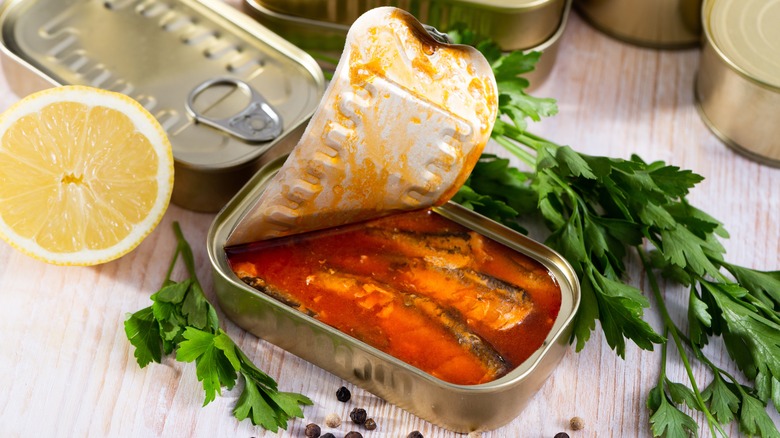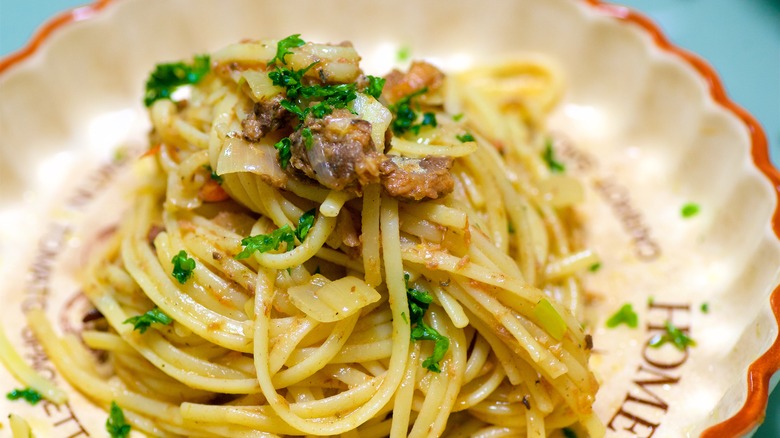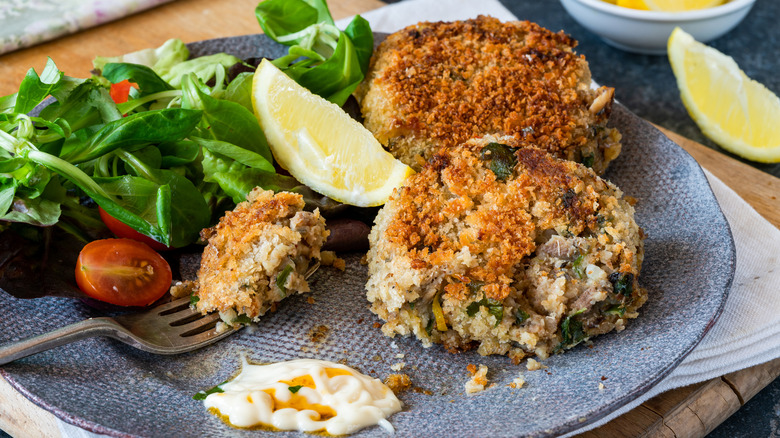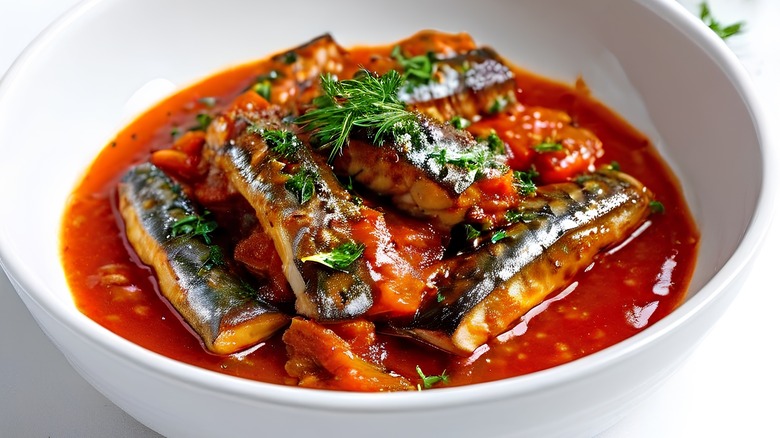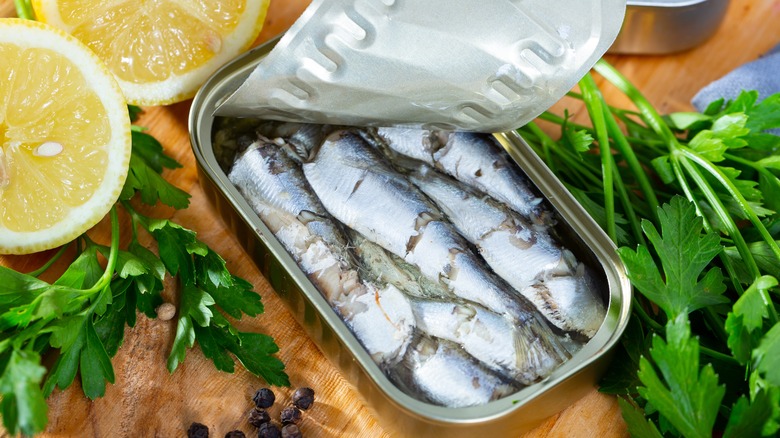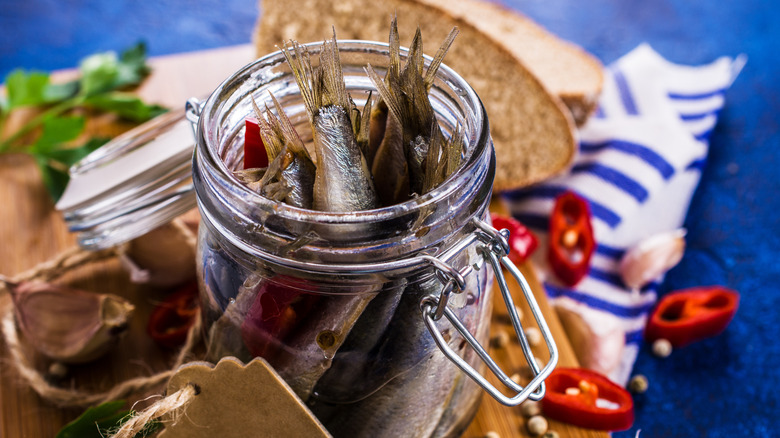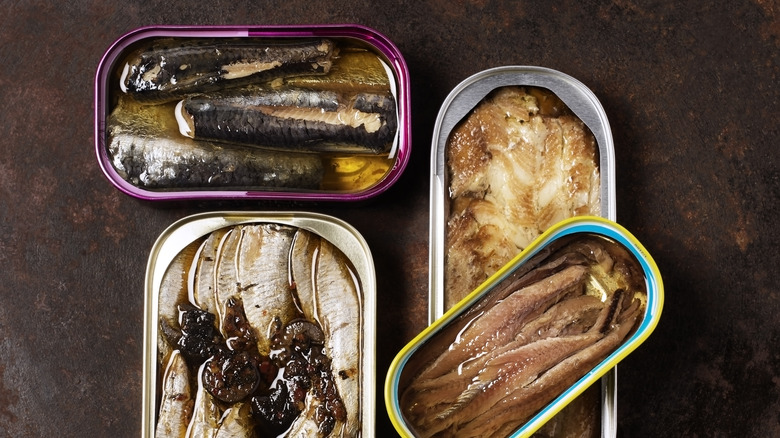You've Been Using Canned Sardines Wrong This Entire Time
Canned sardines are all the rage these days. This may be due to the fact that not only are they delicious, they are also very nutritious and affordable, making them one of the absolute best canned foods to eat for breakfast. They are a nutrient-dense seafood option for your diet that provides heart healthy omega-3 fatty acids that help with reducing inflammation, strengthening bones, and improving cognition. In addition, they are a big plus for pregnant women as they support healthy fetal development as they are a good source for calcium and vitamin D — crucial elements for fetal bone development. Canned sardines also have much lower levels of mercury compared to other seafood options, making them an ideal pick for those that want to lower their risks of getting mercury poisoning significantly.
However, despite their many benefits, canned sardines can be off-putting if used incorrectly — either because of an unpleasant taste from improper preparation or because you miss out on their full nutritional value. While canned sardines are definitely on our list of canned foods that you should always keep in your pantry, we've also carefully curated a list of ways to help you make the most of them, so they're not just a backup meal for emergencies like a global pandemic, but a versatile and valuable addition to your everyday cooking.
Think twice before eating straight from the can
Since sardines are pre-cooked before they're sealed in the can, it's tempting to grab a fork and dig in right after opening. But doing so can be limiting, and may keep you from fully enjoying all the goodness sardines have to offer. We get it — canned sardines are a quick and efficient addition to any meal. But there are plenty of creative ways to enjoy them that are just as fast and easy to prepare. After all, life's too colorful for boring meals.
From quick sardine salads and sandwiches with toast and guacamole to flavorful sardine patties and hearty rice or grain bowls, there are countless easy and delicious ways to enjoy your canned sardines. Canned sardines will also majorly upgrade your bowl of pasta if given the chance. Another quick and easy way to take your canned sardines to the next level is by making sardines rillettes where you simply mash your sardines, add lemon juice and butter, paste them onto a slice of garlic bread and you're good to go. With so many delicious ways to eat and prepare sardines, you're doing them a disservice if you're just eating them straight from the can — tempting as it may be.
A little heat goes a long way with canned sardines
Since canned sardines are already pre-cooked, only minimal amounts of heat are preferred if you really need to cook them again, otherwise they will become dry and less appealing. For example, when making a sardine curry, canned sardines — unlike fresh ones — only need to be sautéed for less than a minute. Any longer, and you risk them falling apart in the curry, leaving you with a messy and less-than-pleasant dish.
To avoid overcooking, you can try adding the canned sardines at the very end of the cooking process. Once your sauce or dish is fully cooked, gently fold the sardines in and let them warm through using residual heat. This will help preserve both the texture and flavor of the sardines while complimenting your beautiful dish. When using canned sardines, it's very important to remember that they were either steamed, boiled, or fried before the can was sealed, so heat isn't really a necessity — there really is no need to fix what isn't broken.
Don't toss that brine, it's liquid gold
A common mistake many people make is discarding the brine or oil after opening the can. That oil is quite underrated because so much can be done with it to take your dishes to the next level. It can be a flavorful and versatile enhancer for a variety of dishes — whether it's boosting your salad dressings, serving as a rich base for sauces, or reducing the need for extra salt by using the brine in its place.
A simple potato salad can be completely transformed just by adding the oil from canned sardines and will definitely leave any guest wondering what your secret ingredient is. Another fun thing to do with the leftover oil is make sardine butter with it. Simply add the oil into a container and mix with butter, sardine bits, and herbs of your choice. Finally, place the mixture in the fridge so that it solidifies, and use it as a spread whenever you want toast or a sandwich with a kick to it. Also, it would be wise to treat the oil as any other opened can of sardines, since little bits of sardines might have been left behind in the oil, so use it within a few days before you officially throw it out.
The bones aren't the enemy, they're a bonus
We get it, the fear of choking on a fish bone is real and natural, but the bones found in canned sardines aren't like the ones you would find on a grilled mackerel. These bones are actually very soft since the sardines are cooked beforehand, and are something to look forward to since they are also very nutritious and a good source of calcium. The calcium found in sardine bones provides 38% of the recommended daily intake from just a single serving, so you'll be doing yourself a favor by eating them as it also contributes to supporting your cardiovascular health and muscle strength.
If you're looking to hit that calcium target, then eating sardine bones would definitely get the job done — and it's a cost friendly route as well. The bones found in canned sardines are also safe for making baby food as they crush effortlessly between your fingers. Add some avocado to the mashed sardines and you'll have a very yummy treat for your baby.
Sometimes, a quick debone makes all the difference
Although the bones are quite soft, edible, and high in nutritional value, some canned sardine recipes work better without. When making sardine patties, you'll need to remove the bones from the sardines first before mashing them for best results. After this, you can easily add in your herbs, eggs and breadcrumbs and begin shaping the patties. Some canned sardines come already deboned, making them a quick and convenient option for those who want to save time and skip the extra step. Besides deboning for the sake of your dish's texture, sometimes it is necessary to do so for the overall presentation of your meal. Bones that are floating around can risk making a salad look untidy and messy.
Deboning is also very helpful when serving sardines to people who may be unfamiliar with them or are hesitant about eating fish bones. Do not assume that all guests will know about how harmless and soft they are. Taking a moment to remove the bones can make the dish more approachable and enjoyable — especially for kids or those new to sardines. It's a small step that can turn skeptics into fans, if handled correctly.
A quick rinse can save your dish
Some canned sardines come dipped in sauces like tomato sauce, and the flavors can vary from mild to super hot. If you aren't a fan of strong flavors, you can rinse the sardines in milk after draining the sauce. However, even if you are a fan of strong flavors, it is also important to make sure that the sardines flavor is not overpowering the rest of the dish. In this instance, rinsing them in milk would be an option again. For example, canned sardines are sometimes used to only compliment a dish and not as the star of the show, like when making pasta, rice bowls, or mixed vegetable stir fries. In these cases, toning down the intensity allows the sardines to blend in seamlessly, adding a savory depth without dominating the overall flavor profile.
Also, if you're going to be serving a dish with sardines — such as a salad — to people that aren't too crazy about fish, then rinsing them in milk would be another smart move. We recommend soaking them in milk for an hour before using them. This will make the bold flavors in the sardines approachable. Here's a tip: Do not throw away the tomato sauce after draining the sardines in case you soak them for too long and the flavor becomes dull. You can always use a bit of the original sauce to bring the flavor back into balance.
Don't heat them in the can, it's not worth it
One thing that should not be done at all is heating the sardines while they are still in the can. It is dangerous. The risk of harmful chemicals being released is very high, and could lead to serious medical complications. A little patience goes a long way in this regard — simply transfer your sardines (with the sauce or oil) into a heat friendly container and heat them. Yes, even if you've gone out on a camping trip and want to heat the sardines — make sure you take a suitable container and use that to heat them. According to Scientific American, the majority of canned food comes in steel. The steel that the can is made of usually contains toxins such as chromium and nickel which are released when the tin is heated, and although the effects are not instant, it could lead to cancer and diabetes over time.
Heating up sardines while they are still in the can also usually results in Bisphenol A (BPA) leaching into the food which also increases one's risk of cancer and diabetes. We know it may seem like a waste of time, but transferring them to a pan or microwave-safe dish is a simple step that protects your health and ensures even heating. A few extra seconds can go a long way in preserving both the quality of your meal and your well-being.
Sardines shine best with the right flavor balance
Canned sardines usually come in oil, brine, water or sauce. This means that they are not all going to taste the same, so they have to be treated differently. A salad made with canned sardines in oil will taste noticeably different if, the next time, you use sardines soaked in sauce instead. The type of liquid they're packed in can significantly change the overall flavor of your dish. It's all about balancing the flavors and knowing when to use what and what to pair them with. We recommend pairing canned sardines that have strong fishy tastes with bright, fresh, and acidic ingredients, such as lemons or a splash of vinegar. Fresh herbs like parsley, cilantro, or dill will also add some freshness to heavily flavored sardines. (Tip, Italian parsley works wonders for this).
Also, when served at room temperature, sardines tend to have a milder fishy taste compared to when they're hot. So, if you don't have any bright or acidic ingredients on hand and hungry guests are waiting, we recommend serving them at room temperature — just in moderation. Canned sardines can easily bring flavor to your meals with the right pairings. Sardines packed in water are mild in flavor, making them a great addition to salads that already have a main star, like chicken salad. They'll complement the dish without overpowering it. Adding in hot sauce or black pepper will make sardines that were packed in water more interesting while pickles and celery will help bring texture to them.
Keep that brine in if there are leftovers
If you're not going to use all the contents in the can at once, store them in the fridge without draining the oil. Draining the oil will result in the sardines potentially becoming dry and losing their flavor. If you're not ready to use the entire can of sardines inb one go, that's totally fine — just leave the leftovers in the oil. As the sardines remain submerged in the oil, their fat content will remain intact and the fish will remain moist as well. The oils help to prevent oxidation by providing a protective barrier to oxygen for the sardines.
If you make the mistake of throwing away the oil, you can use olive oil as a substitute to preserve the sardines, although it won't be as effective as using the original oil. It will, however, preserve some of the flavor left in the sardines, and a little flavor is better than no flavor at all. It's also important to make sure that the leftover sardines and oil are placed in an airtight container before being placed in the fridge. A glass container is your best bet, as it eliminates the risk of potential leaching and helps preserve the sardines' quality and flavor.
Don't let an open can ruin your sardines
Sardines canned in oil or water typically tend to drop in quality after being open for one day. This means that the longer you keep your can of sardines open, the more you'll lose out on all the juicy, flavorful goodness those sardines have to offer. Besides affecting the quality of your sardines, leaving them in an open can is also a health risk because the tin lining's exposure to oxygen can lead to increased leaching of metals such as zinc and iron which becomes dangerous for consumption. After opening the can of sardines, we recommend transferring the contents into a clean and airtight container. Also, mark the containers with the date of storage to make it easy to keep track of how long they have been in your fridge or freezer.
It is typically recommended to refrigerate sardines from cans within two hours of opening them and use them within three to four days of refrigerating them. Keeping them longer than this will not only cause quality issues for you, but will pose a health risk as well. If you really have to store your sardines for longer than four days, freezing them would be your best bet — just remember to place them in freezer safe containers.
Sardines aren't tuna, give them their moment
Since canned sardines are a common item to find in your pantry, it's very tempting to want to use them as a tuna substitute when you've run out of it. But, here's the thing, using canned sardines in a recipe that was originally designed to be a tuna dish will be a major injustice to the sardines. Don't assume they are easily interchangeable — use sardines when you are looking for rich bold flavors, not just as a substitute for a tuna salad. If you're hunting for the real reason why you should avoid canned tuna, sardine flavors are quite bold and fishy while tuna flavors are mild. Adding sardines in a recipe originally meant for tuna will just overpower your dish, which might lead to extra work since you'll probably need to figure out a way to balance out the flavor and hunt for more ingredients in your pantry. It all seems messy and not worth it really.
Another thing, sardines are tender and soft while tuna is firm and flaky, making tuna ideal for salads and sardines for sandwiches and mashed recipes. While both sardines and tuna have omega-3 fatty acids and are very nutritious, sardines contain heavy amounts of calcium and vitamin D which are not as dominant in tuna. That said, canned sardines deserve to take center stage in a dish, not just linger in the background, only brought out when the tuna runs out. With their rich flavor and versatility, they have every right to shine on their own.
